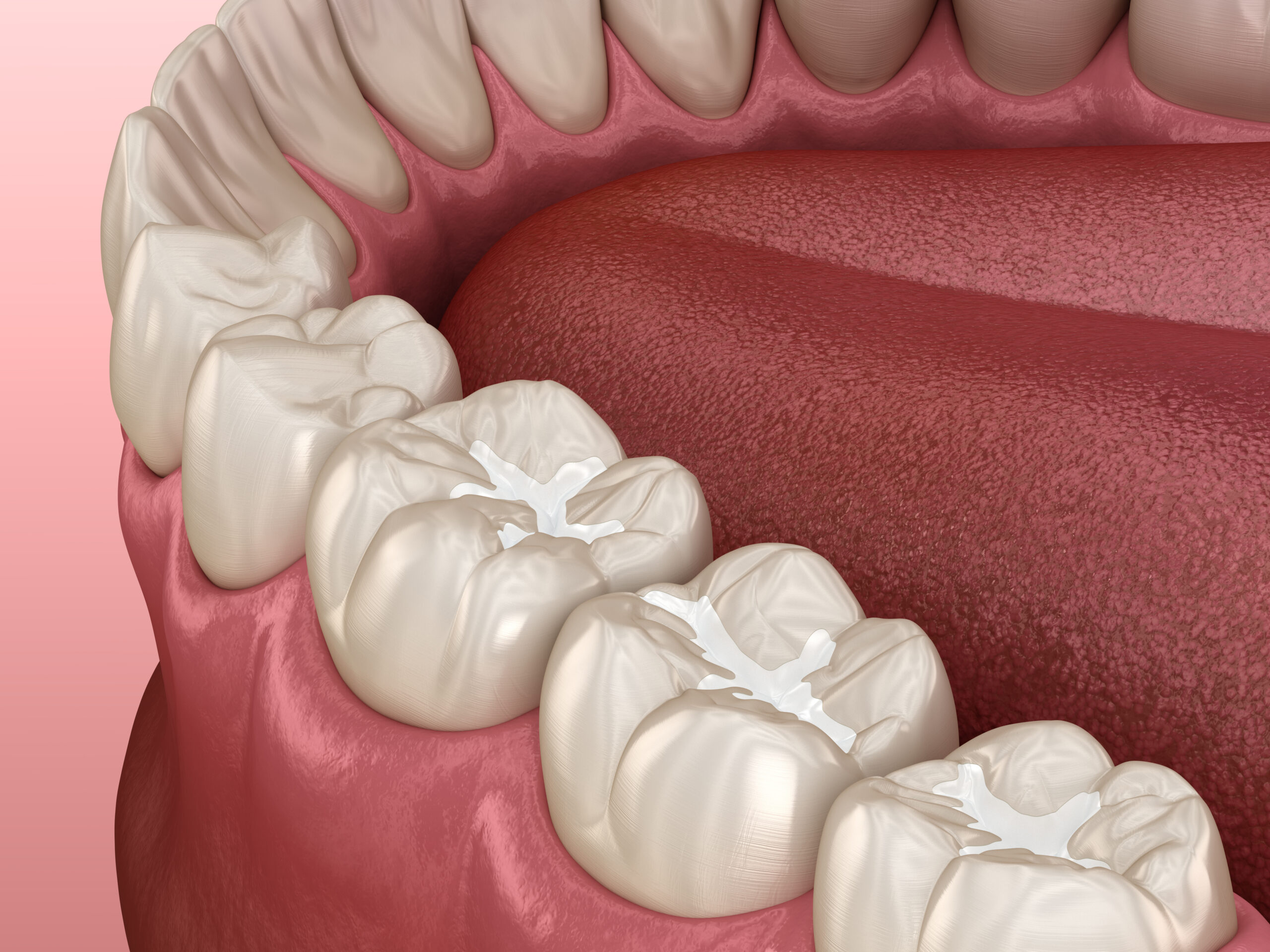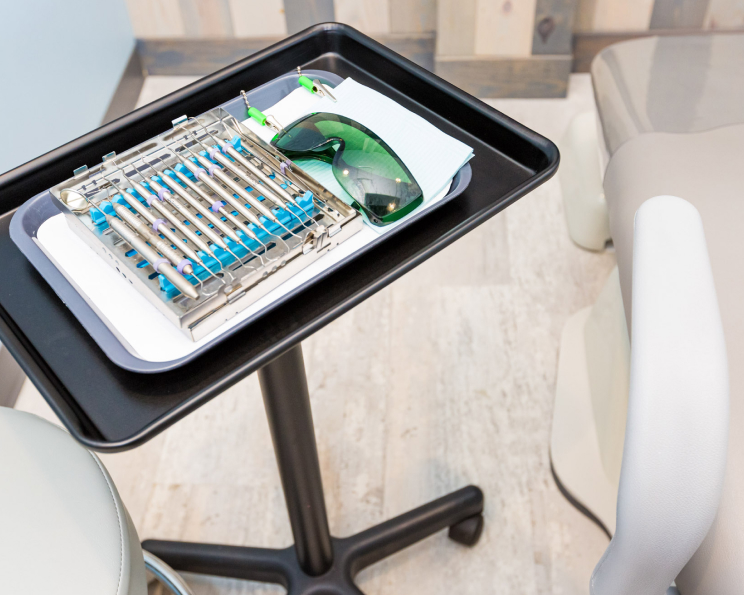Dental Sealants
Molars and premolars serve the crucial function of crushing and grinding food. While their unique design serves a vital functional purpose, due to the grooves and fissures in their surface, cleaning molars properly with conventional methods such as flossing and brushing can be difficult.
This is where our dental sealants come in. Sealants are a thin, protective coating applied on the surface of molars and premolars to seal out food particles and plaque buildup. Depending on your situation, we offer three main types of dental sealants.

They include:
- Composite resin sealants: This type of sealant is made from acrylic resin. It’s gel-like when applied but hardens into a tooth-colored material when exposed to a curing light. Composite resin sealants are the most commonly used type of dental sealant.
- Glass ionomer sealants: Glass ionomer sealants are made of glass and acrylic ionomer materials. While they are less durable than composite resin sealants, they bond better to the chewing surface. Glass ionomers release fluoride to strengthen the enamel, making them ideal for teeth showing early signs of decay.
- Polyacid resin sealants: This type of sealant combines the best features of resin and glass ionomer sealants. Polyacid resin sealants are easier to apply than composite sealants. They also last longer than glass ionomer sealants.
How Do Dental Sealants Work?
Dental sealants work by creating a physical barrier against tooth decay agents, making them an invaluable method of dental decay prevention. Molars and premolars have deep tooth fissures and grooves that can be impossible to clean with regular brushing and flossing. These grooves trap food particles and create an ideal environment for harmful oral bacteria.
Since the sealant is liquid during application, it flows into grooves on the teeth’s surface, forming an airtight seal once it hardens. Dental sealants are remarkably resilient. They can last up to ten years if applied properly. Their longevity and affordable cost make dental sealants important for children’s dental health.

Why Do You Need Dental Sealants?
Sealants are a preventative treatment which protects the tooth surface. This makes them particularly beneficial for children and teenagers whose molars and premolars are starting to grow. That said, sealants can provide teeth protection for people of all ages. Dental sealants are generally recommended for the following cases:
- Erupting Molars and Premolars: Children should receive dental sealants when their permanent premolars and molars erupt. Applying sealants on these teeth will protect them from tooth decay for many years.
- Cavity-prone adults: While dental sealants are mostly recommended for children, they are also beneficial for cavity-prone adults. For instance, sealants will protect your tooth enamel surface from rapid deterioration if you have a history of chronic tooth decay. Additionally, adults with naturally deep grooves and fissures in their molars can use dental sealants as a cavity-prevention solution.
- Orthodontic Patients: Orthodontic appliances such as braces make properly cleaning teeth difficult. Dental sealants can help protect the teeth by preventing bacteria and plaque buildup in the teeth of orthodontic patients.
Benefits of Dental Sealants
Dental sealants have several benefits. They include:
- Protection against tooth decay: Dental sealants form an impregnable barrier that protects your teeth from decay and enamel deterioration. They prevent bacteria and plaque buildup in hard-to-clean places in your molars.
- Longevity: Sealants are a long-lasting preventative measure. They can remain effective for up to ten years if applied correctly. Furthermore, sealants can be easily re-applied if they break down.
- Quick and painless application: The tooth sealing procedure is non-invasive and straightforward. No anesthesia or drilling is required. Moreover, the sealing process only takes a few minutes per tooth and causes no discomfort.
- Cost-effective: Dental sealants are an affordable cavity prevention measure that provides continuous protection for many years. Tooth sealing can save money by preventing future invasive and expensive treatments like root canals.
- Improves dental hygiene: Sealants form a smooth protective barrier around the tooth. Since the smooth surface is easier to clean, sealants improve the dental hygiene of children and individuals unable to clean their teeth properly.
- Helpful for kids and grown-ups: Dental sealants are mostly recommended for children but can also benefit cavity-prone adults and individuals with poor oral health.
What to Expect During a Tooth Sealing Procedure
Sealants are lauded in pediatric dentistry as an effective decay prevention measure. Moreover, the quick and non-invasive application procedure is ideal for children and teenagers.
Here’s what you can expect during a dental sealant procedure:
- Tooth Prep: We first prepare the teeth to be sealed by cleaning them to remove food particles and plaque buildup. The teeth are scrubbed using a polishing brush and then dried using an absorbent material.
- Isolation: Next, we isolate and dry each tooth using cotton. Isolation prevents saliva from interfering with the sealant paste.
- Etching: We treat the chewing surfaces of your teeth with a mild acid etch solution. The solution roughens the enamel surface, which helps the sealant bond with the tooth.
- Drying: The etching solution is rinsed off after 15 seconds. The dentist will then dry the teeth to be sealed to ensure the sealant paste adheres firmly to the tooth.
- Sealant Application: We then apply the dental sealant material to the surface of the teeth. The sealant will flow into the pits and grooves of the molars and form a protective barrier as it hardens.
- Sealant Curing: We might use a special curing light to harden the sealant. This depends on the thickness of the sealant layer and the type of sealant paste used.
- Final check-up: We wrap up the process by carefully checking whether the sealant interferes with your chewing. The dentist will also check for structural defects that can compromise the sealant.
The best part is that the sealing process only takes a few minutes per tooth. Furthermore, tooth sealing is a painless and non-invasive procedure.
Aftercare Tips for Dental Sealants
While dental sealants are a long-lasting dental solution, they need proper care to provide continuous protection for your teeth. These tips will help you prolong the lifespan of your dental sealants.
- Practice good dental hygiene: Regular brushing and flossing can prevent bacteria and plaque buildup from compromising dental sealants.
- Visit your dentist regularly: Your dentist will inspect your sealants to ensure they remain intact. They will schedule repairs to fix chipping and sealant deterioration if necessary.
- Avoid chewing on hard foods: Hard foods such as popcorn, nuts, and ice can chip the sealant surface, creating fissures where plaque and bacteria will build up.
- Refrain from grinding your teeth: Grinding your teeth can increase sealant deterioration. Your dentist can recommend a mouthguard to protect your sealants from the wear and tear caused by grinding your molars.
- Be gentle when brushing: Use a toothbrush with soft bristles that won’t graze the sealant. Also, brush your teeth gently to avoid dislodging the sealant and damaging your gums.

Dental sealants are an affordable, non-invasive, and highly effective cavity prevention measure. Understanding how they work will help determine whether sealants are best for yourself or your children’s dental health. In short, opting for dental sealants will ensure your teeth remain healthy and cavity-free for many years.
Schedule Today!
We look forward to meeting you. Call us or request an appointment online to set up your first visit. We’ll be in touch soon.

